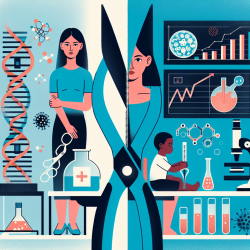Introduction
Speech and language acquisition is a cornerstone of early childhood development, laying the foundation for literacy and academic success. Recent research, "Measuring the Impact of Genetic and Environmental Risk and Protective Factors on Speech, Language, and Communication Development-Evidence from Australia," provides valuable insights into the factors influencing these critical skills. This blog aims to help practitioners enhance their skills by implementing the research outcomes or encouraging further exploration.
Understanding the Research
The study conducted in Australia examined the impact of genetic and environmental factors on speech, language, and communication development among 5000 infants. The research revealed that protective factors associated with the infant's family, in utero environment, and early infant health significantly influence language development. Interestingly, the impact of genetics was less clear, suggesting that environmental interventions may play a more substantial role in early development.
Key Findings for Practitioners
- Family Environment: The family environment, particularly positive parenting practices, plays a critical role in language development. Practitioners should focus on empowering parents with strategies to create a nurturing and stimulating home environment.
- In Utero and Early Health: Prenatal care and early health significantly affect language outcomes. Encouraging healthy behaviors during pregnancy and monitoring infant health can optimize development.
- Targeted Interventions: While genetics play a role, the dominance of environmental factors suggests that interventions should focus on enhancing the home environment and addressing specific needs in speech and language.
Practical Applications
Practitioners can leverage these findings to develop targeted intervention strategies:
- Parental Engagement: Encourage parents to engage in activities that promote language skills, such as reading aloud, storytelling, and interactive play.
- Health Monitoring: Work closely with healthcare providers to ensure that infants receive appropriate prenatal and postnatal care, addressing any health concerns promptly.
- Customized Therapy: Develop individualized therapy plans that consider the unique environmental and genetic factors affecting each child.
Encouraging Further Research
While this study provides valuable insights, it also highlights the need for further research to disentangle the complex interplay between genetics and environment. Practitioners are encouraged to stay informed about the latest developments in the field and contribute to ongoing research efforts.
Conclusion
The research underscores the importance of environmental factors in early language development. By focusing on enhancing protective factors and addressing risk factors, practitioners can significantly impact children's speech, language, and communication skills. Empowering parents and tailoring interventions to individual needs will pave the way for optimal development.
To read the original research paper, please follow this link: Measuring the Impact of Genetic and Environmental Risk and Protective Factors on Speech, Language, and Communication Development-Evidence from Australia.










